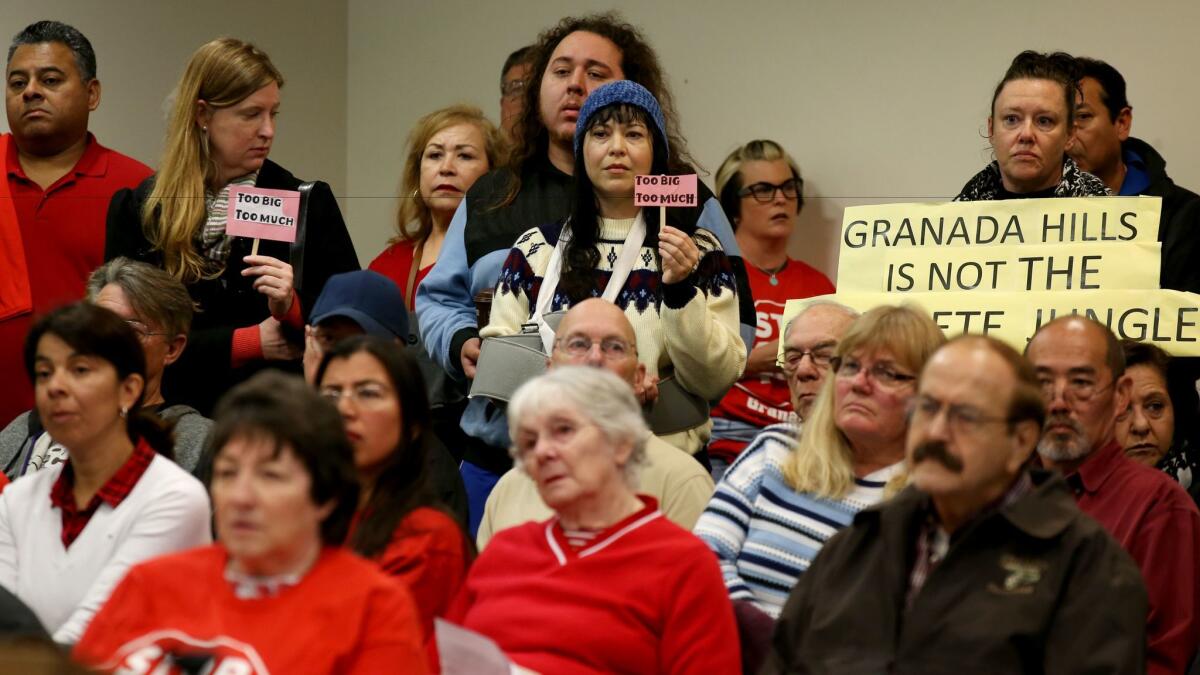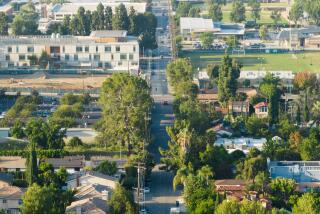L.A. community plans languished for years. Now they’re an unlikely issue in the March election

Eleven years ago, Los Angeles officials invited residents of San Pedro to help rewrite their neighborhood’s community plan, which spells out where new housing and other amenities would be allowed.
Dozens took part in the effort. Yet the document is only now heading to the City Council for a vote — a situation one longtime resident called “depressing.”
“It’s obvious that the city either can’t, or won’t, make the commitment to doing these plans,” said Doug Epperhart, who sits on the Coastal San Pedro Neighborhood Council.
L.A.’s collection of community plans, and the city’s longstanding failure to update them, have emerged as a major issue in the March 7 election campaign. The plans are considered central to the work of real estate development, spelling out what can be built on each street. Yet they have languished for years, as the city coped first with a recession and then a legal defeat.
Measure S, which would impose new restrictions on development, recommends that those plans be updated every five years. L.A.’s elected officials, many of them opponents of Measure S, rushed last week to have those documents rewritten every six years, at a cost of $10 million annually.
There will always be growth. We have to figure out where we’re putting that growth.
— Councilman Jose Huizar
For all the talk at City Hall of reshaping land use to make Los Angeles more dense and less car-dependent, many of the neighborhood plans have not been rewritten to reflect that vision. Twenty-nine of the city’s 35 community plans have not been updated since 2001 — leaving many of them out of date in a rapidly changing city.
For example, downtown’s Arts District has evolved from an expanse of warehouses and cold storage facilities into a lively neighborhood, with high-end housing and restaurants. Yet much of it is still zoned for manufacturing.
In the San Fernando Valley, the Metro Orange Line, an 18-mile dedicated bus route, has been open for more than a decade. Yet city officials just started working on documents to focus development around key stations.
Housing advocates have long complained that the plans don’t reflect changing real estate conditions, transportation patterns and community needs. Because those documents have fallen behind, city lawmakers have found themselves rewriting the rules on a project-by-project basis.
Those approvals frequently result in buildings that are larger than the originally planning rules allowed. And they have sparked an outcry, with neighborhood activists complaining that zoning rules are too often rewritten.
That discontent is being tapped by proponents of Measure S, sponsored by the Hollywood-based AIDS Healthcare Foundation.
Measure S would ban for two years the city’s practice of changing key planning rules for individual real estate projects, such as approving buildings taller than existing law allows. The moratorium could be lifted early if city leaders show they have updated each of those plans. Foes of Measure S say that sets up an impossible goal, since each plan typically takes a minimum of three years to complete.
The council’s latest strategy would ensure that all are updated by 2024.
Community plans are one of the main tools Los Angeles uses to prepare for future population growth, anticipating where additional homes and job centers can be built. Yet most of those plans were adopted years before the region’s rail network expanded into Pasadena, Santa Monica and East Los Angeles.
City leaders say the plans should already have been updated to ensure that higher-density housing and other amenities can be built near transit stops.
“There will always be growth,” Councilman Jose Huizar said. “We have to figure out where we’re putting that growth … and in what parts of the city. But if we don’t have the basic elements in our community plans, we really don’t know where we’re headed.”
If each plan was up to date — and written to reflect the region’s urgent need for housing — developers would not make as many requests for deviations from city planning rules, said Mark Vallianatos, a founder of the advocacy group Abundant Housing L.A.
Those developers would also feel less of a need to hire consultants, provide campaign donations and contribute to the projects and organizations favored by city politicians, said Vallianatos, who opposes Measure S.
“If you had fewer exemptions, you wouldn’t need to be buddies with the council person,” he said. “You get the land, you follow the rules. It’s a simpler planning process.”
Backers of Measure S say elected officials grant those rule changes because they need campaign donations from those same developers. Voters should not be fooled into thinking that L.A. leaders will follow through on their promise to do more planning, said Jill Stewart, a spokeswoman for the Yes on S campaign.
“They don’t want to plan,” she said. “They are not going to get huge contributions for following a plan. They get huge contributions from deviating from plans.”
L.A.’s last serious effort to update its community plans was launched a decade ago, at the tail end of a major real estate boom. That initiative, which called for revisions to approximately a third of the city’s plans, quickly stalled amid the 2008 global economic downturn.
Facing a $484-million budget shortfall, city leaders cut staffing in the Department of City Planning and elsewhere, halting or slowing work on nonessential initiatives.
“Given the choice of laying off cops or slowing down the community plans, that wasn’t a difficult decision,” said Mayor Eric Garcetti. “But it had a real effect, and a real impact.”
As the city emerged from the recession, officials made the greatest progress on a single community plan — one covering Hollywood. That area was experiencing a burst of development activity, due in part to the opening of the Metro Red Line subway. Yet its plan had not been updated since 1988.
Developers were regularly asking for, and receiving, zone changes, height district changes and other deviations from city rules now targeted by Measure S.
The council voted in 2012 to approve a new Hollywood plan, one that allowed larger residential buildings along major transit routes. Neighborhood groups quickly sued, citing concerns over traffic and infrastructure.
A judge struck down the plan the following year, forcing the council to go back to the rules from 1988. Developers continued seeking the zoning changes and height increases that had infuriated local activists, many of whom later backed Measure S.
The ruling also slowed down the effort to update other community plans. Planners worked to determine whether those other documents were also legally vulnerable, a process that lasted about a year.
“We had to make sure we were not repeating any of what happened in the Hollywood case,” said principal city planner Craig Weber, who is heading up the latest effort to update the community plans.
Weber said the city is getting back on track, with several new plans in the pipeline. But the effort is time-consuming, he said.
City staffers must head out to neighborhoods to gather input. They examine requests for historic preservation zones and other development restrictions. And they must prepare a legally defensible environmental impact report for each plan, Weber said.
Over the last two years, the council has updated plans in Sylmar, West Adams and Granada Hills. Yet even with those updated rules, confrontations between developers and neighborhoods persist.
In 2015, the council approved the Granada Hills plan after dozens of community meetings. During those deliberations, residents succeeded in having key locations “downzoned,” slashing the number of homes that could be built on certain properties.
Once the plan went into effect, real estate company Harridge Development Group filed an application to build 440 apartments at a site on San Fernando Mission Boulevard. The request complied with local and state planning rules.
Under the old Granada Hills plan, the site would have allowed up to 864 new homes. The new 2015 plan cut that number to 432. Harridge requested eight extra apartments — its right under state law — in exchange for providing some affordable housing.
Residents reacted with fury, saying the project would turn the area into a “ghetto.” Dozens showed up at a hearing on the project last week, saying new apartments would bring increased burglaries, traffic congestion and drug trafficking.
Kyndra Casper, an attorney for Harridge, said her client simply followed the rules. “The community got what they asked for,” she said. “And now that a project is being proposed under that plan, they don’t like it.”
In the wake of the outcry, Harridge agreed to scale back its project to 330 homes, making all of them condominiums. But some residents say it is still too big — and are unswayed by arguments that the developer complied with the property’s new zoning.
“We don’t want to be mini-Manhattan,” said Granada Hills resident Julie Trent.
Councilman Mitchell Englander, who represents the area, said the experience shows that a brand new set of community plans will go only so far in satisfying neighborhoods.
“There’s a lot of conversation out there saying that … if the community plans were simply updated, we would fix everything,” he said. “I can’t tell you how false that is.”
Twitter: @DavidZahniser
ALSO
92-year-old man charged in Valentine’s Day killing of wife
Will the crisis at Oroville Dam become a catalyst for change?
More to Read
Start your day right
Sign up for Essential California for news, features and recommendations from the L.A. Times and beyond in your inbox six days a week.
You may occasionally receive promotional content from the Los Angeles Times.







